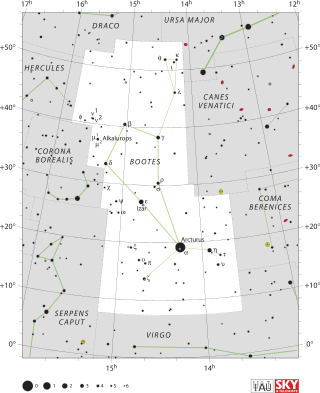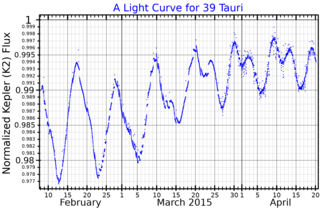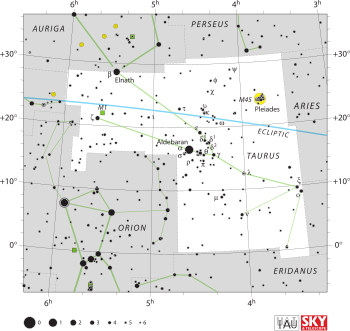
18 Scorpii is a solitary star located at a distance of some 46.1 light-years from the Sun at the northern edge of the Scorpius constellation. It has an apparent visual magnitude of 5.5, which is bright enough to be seen with the naked eye outside of urban areas. The star is drifting further away with a radial velocity of +11.6.

21 Tauri, formally known as Asterope, is a component of the Asterope double star in the Pleiades open cluster. 21 Tauri is the stars' Flamsteed designation. This star is potentially faintly visible to the naked eye with an apparent visual magnitude of 5.76 in ideal conditions, although anybody viewing the object is likely to instead see the pair as a single elongated form of magnitude 5.6. The distance to 21 Tauri can be estimated from its annual parallax shift of 7.6 mas, yielding a range of around 431 light years. It is moving further from the Earth with a heliocentric radial velocity of +6 km/s.

μ Tauri, Latinized as Mu Tauri, is a single star in the equatorial constellation of Taurus. It has a blue-white hue and is faintly visible to the naked eye with an apparent visual magnitude of 4.27. The star is located approximately 490 light years distant from the Sun based on parallax, and is drifting further away with a radial velocity of +16 km/s.
Psi Tauri, which is Latinized from ψ Tauri, is a solitary star in the zodiac constellation of Taurus. It has a yellow-white hue and is visible to the naked eye with an apparent visual magnitude of +5.22. The distance to this system, as determined using an annual parallax shift of 36.2 mas as seen from the Earth, is 90 light years. It is drifting further away with a radial velocity of +9 km/s.
Rho Telescopii is the Bayer designation for an astrometric binary star system in the southern constellation of Telescopium. It is visible to the naked eye, with an apparent visual magnitude of +5.17. Based upon an annual parallax shift of 17.63 mas as measured from Earth, it is located approximately 185 light years from the Sun.

Upsilon Aquarii, Latinized from υ Aquarii, is the Bayer designation for a binary star system in the equatorial constellation of Aquarius. It is visible to the naked eye as a faint star with an apparent visual magnitude of 5.21. Parallax measurements give a distance estimate of 74.8 light-years from Earth. This is a high proper-motion star that is drifting closer to the Sun with a radial velocity of –2.3 km/s. It is part of the Hercules-Lyra association.
47 Arietis is a single star in the northern constellation of Aries. The designation is from the star catalogue of English astronomer John Flamsteed, first published in 1712. It is faintly visible to the naked eye with an apparent visual magnitude of 5.80. It has an annual parallax shift of 30.15 ± 0.30 mas, which is equivalent to a physical distance of approximately 108 light-years from Earth.

Sigma Boötis, its name Latinized from σ Boötis, is a single star in the northern constellation of Boötes. It has a yellow-white hue and is visible to the naked eye with an apparent visual magnitude of 4.46. Located to the southeast of Rho Boötis, the dwarf Sigma may at first appear as a naked-eye double, but the angular proximity with Rho is merely line-of-sight. Sigma Boötis is located at a distance of 51.1 light years from the Sun based on parallax. The star has a relatively high proper motion and is traversing the sky at the rate of 0.230″ yr−1.
HD 102195 is an orange-hued star in the zodiac constellation of Virgo with a confirmed exoplanet companion. With an apparent visual magnitude of 8.07, the star is too faint to be seen with the naked eye. The distance to HD 102195 can be estimated from its annual parallax shift of 34.06 mas, yielding 95.8 light years. It is moving further away from the Earth with a heliocentric radial velocity of 1.85 km/s. This is a high proper motion star and a possible member of the η Cha stellar kinematic group.

HR 511 is an orange dwarf of spectral type K0V in the constellation Cassiopeia. With an apparent magnitude of 5.63, it is faintly visible to the naked eye. The star is relatively close, 32.8 light years from the Sun.

Iota Piscium is a single, F-type main-sequence star located 45 light years from Earth, in the constellation Pisces. Its spectral type is F7V, which means that it is somewhat larger and brighter than the Sun, but still within the range considered to have the potential for Earth-like planets. It has a surface temperature of about 6,000 to 7,500 K. Iota Piscium is suspected to be a variable star, and was once thought to have one or two stellar companions, but both are line-of-sight coincidences. It displays a far-infrared excess at a wavelength of 70μm, suggesting it is being orbited by a cold debris disk.
HD 44594 is a star in the southern constellation Puppis. It has an apparent visual magnitude of 6.64, so it can be seen with the naked eye from the southern hemisphere under good viewing conditions. Based upon parallax measurements, it is located at a distance of 85 light-years from the Earth, giving it an absolute magnitude of 4.56.

111 Tauri is a wide binary star system in the constellation Taurus. It is located at a distance of 48 light years from the Sun. Primary component A is a main sequence star with a stellar classification of F8V. The secondary component B is a K-type main sequence star. The primary is larger and more luminous than the Sun, with about 130% of the Sun's radius and 185% of the Sun's luminosity. The apparent magnitude of 5.0 indicates it is a faint star that can be viewed by the naked eye under good, dark-sky conditions.

Chi Ceti , is the Bayer designation for a double star in the equatorial constellation of Cetus. They appear to be common proper motion companions, sharing a similar motion through space. The brighter component, HD 11171, is visible to the naked eye with an apparent visual magnitude of 4.66, while the fainter companion, HD 11131, is magnitude 6.75. Both lie at roughly the same distance, with the brighter component lying at an estimated distance of 75.6 light years from the Sun based upon an annual parallax shift of 43.13 mass.
90 Tauri is a star in the zodiac constellation of Taurus, located 144 light-years away from the Sun. It is visible to the naked eye as a faint, white-hued star with an apparent visual magnitude of 4.27. 90 Tauri is a member of the Hyades cluster and is listed as a double star.
114 Tauri, or o Tauri, is a single, blue-white hued star in the zodiac constellation of Taurus. It is a faint star but visible to the naked eye with an apparent visual magnitude of 4.88. The distance to this star, as determined from its annual parallax shift of 5.22±0.21 mas, is roughly 620 light years. It is moving further from the Sun with a heliocentric radial velocity of 16.5 km/s, having come as close as 240 ly (75 pc) some 9.6 million years ago. It is a member of the Cas-Tau OB association of co-moving stars, and has a peculiar velocity of 8.3 km/s.

39 Tauri is a binary star in the northern constellation of Taurus. It has an apparent visual magnitude of 5.90, so, according to the Bortle scale, it is faintly visible from suburban skies at night. Measurements made with the Hipparcos spacecraft show an annual parallax shift of 0.0594728″, which is equivalent to a distance of around 55 light years from the Sun.
39 Leonis is the Flamsteed designation for a star in the zodiac constellation of Leo. It has an apparent visual magnitude of 5.90, so, according to the Bortle scale, it is faintly visible from suburban skies at night. Parallax measurements show an annual parallax shift of 0.0449″, which is equivalent to a distance of around 72.6 ly (22.3 pc) from the Sun.

32 Tauri is the Flamsteed designation for a solitary star in the zodiac constellation of Taurus. It has a visual magnitude of 5.64, making it visible to the naked eye from suburban skies. The position of this star near the ecliptic plane means that it is subject to occultations by the Moon. Parallax measurements put it at a distance of 144 light years from the Sun. It is drifting further away with a radial velocity of +31.9 km/s, having come to within 88.9 light-years some 759,000 years ago.

HD 111395 is a single, variable star in the northern constellation of Coma Berenices. It has the variable star designation LW Com, short for LW Comae Berenices; HD 111395 is the Henry Draper Catalogue designation. The star has a yellow hue and is just bright enough to be barely visible to the naked eye with an apparent visual magnitude that fluctuates around 6.29. Based upon parallax measurements, it is located at a distance of 55.8 light years from the Sun. The star is drifting closer with a radial velocity of −8.9 km/s. It is a member of the Eta Chamaeleontis stellar kinematic group.












